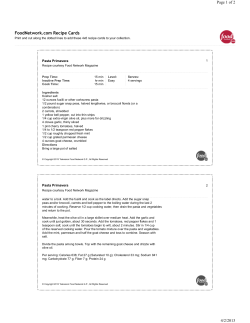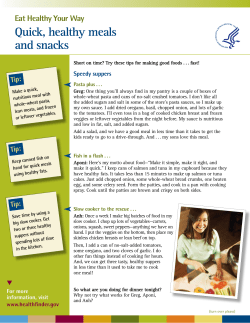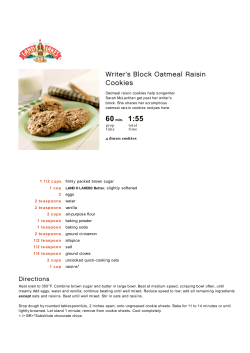
White Bean Pasta Salad Overview Duration: Audience:
White Bean Pasta Salad Authors: Rachel Tessier and Desiree Tande, University of North Dakota Overview Duration: 25 to 35 minutes Audience: Adults Learning Objectives: • Participants will be able to identify a health benefit of using whole wheat instead of just white pasta. • Participants will be able to list two different protein sources that are in the recipe or could be added to the recipe. • Participants will be able to identify the value of adding vegetables to a pasta salad. • Participants will be able to state one health benefit of making their own salad dressing, compared with using a store-bought dressing. Supplies Needs for this Lesson: Cooking Tools: • • • • • • 2 strainers Cutting board Chopping knife Spoon Large pot and lid Can opener Recipe Ingredients: • • • • • • • • • • • • • • • • • • Measuring spoons Measuring cups 1 small bowl 1 large bowl Serving spoon Watch a Video Demonstration http://tinyurl.com/ora2zzt White rotini noodles Whole-wheat rotini noodles Oil White vinegar White sugar Dry mustard Dried basil Dried oregano 1 can (15- to 19-ounce) white beans (you may want to purchase other types of beans such as black or chickpeas as examples of other options; look for low-sodium products) Crumbled feta cheese 3 medium tomatoes 2 celery stalks 1 small jicama (you may want to purchase other types of vegetables that participants may want to try in the recipe such as bell peppers, summer squash or cucumbers for display/ discussion purposes). Lesson Plan Wash your hands. Assemble equipment and prep ingrediants. Get out necessary kitchen equipment (bowls, strainer, cutting boards, knives and measuring spoons/cups); start boiling water in a large pot on the stove, wash tomatoes, celery and jicama. Introduce yourself. Presenta tion Tip If time is lim ited, you m to cook th ay choose e noodles in advanc and wash e and chop most of th vegetable e s (just lea ving enou demonstr gh to ate briefly how to ch them duri op ng the les son). Prior to beginning recipe-lesson, ask about food allergies to ensure no one is at risk. Present & Demonstrate Recipe Steps 1. Add uncooked rotini noodles to boiling water and cook for about 10 minutes. • Explain tthe difference between white and whole-wheat pasta (whole-wheat pasta is less processed, has more fiber and will keep you fuller longer). 2. Measure and combine in a small bowl the oil, white vinegar, white sugar, dry mustard, dried basil, dried oregano, white beans and feta cheese. • Explain how making your own salad dressing is healthier (you control all the ingredients, it’s lower in sodium, you can customize to your own taste) than store-bought dressings (preservatives, high sodium content). • Suggest different types of spices (fresh or dried) to use in the recipe (rosemary, thyme, dill). • Explain the difference between purchasing crumbled feta cheese and feta cheese in brine (the brine makes feta cheese very salty). • Suggest different protein sources to use instead of the white beans (cooked chicken, canned tuna, cooked ham, chickpeas red kidney beans). 2. Drain pasta and run under cold water to cool; drain again. Set aside in the pot. • Explain that running pasta under cold water stops the cooking process and keeps the pasta from getting too soft/ mushy. 3. Chop tomatoes, celery and jicama. • Explain that the vegetables were washed previously with plenty of cold water. • Ask what other types of vegetables could be used in the dish (peppers, red onions, carrots, cucumbers, spinach). 4. Add cooked pasta and dressing mixture to the bowl with chopped tomatoes and celery; gently mix all ingredients together. • Explain how you can keep pasta salad in the refrigerator for quick lunch and supper meals: Cook once; eat all week! • Explain how the longer the ingredients sit in the refrigerator, the more the flavors blend together. Questions? Evaluation (verbal OR written): Verbal Evaluation Option: • Ask participants to explain the benefit of including whole-wheat pasta in place of only white (refined) pasta. • Ask participants to list two different protein sources that could be used in this recipe or are included in the recipe. • Ask participants to list a benefit of adding vegetables to a pasta salad recipe. • Ask participants to state one health benefit of making their own salad dressing, compared with using a storebought dressing. Oral Evaluation Option: • Distribute the evaluation sheet and ask participants to complete it and return it to you before they leave. Wrap Up GIve the participants the take-home handouts and thank them for attending. Course Evaluation Please place an “X” next to your answer: 1. What role do vegetables play in the recipe demonstrated today? oo Add variety of colors and flavors oo Increase nutrient content oo Add different shapes and textures oo All of the above 2. Why is whole-grain pasta used in addition to white pasta in the recipe? ooMakes you feel fuller because it has more fiber ooIs less expensive ooHas more vitamin C 3. Which of the following foods that is in this recipe or could be added to it is NOT a good source of protein? ooWhite beans ooChicken ooChickpeas ooOnions 4. List a health benefit of making your own pasta salad. 5. How can the lesson be improved? Funded by the Heart Disease and Stroke Prevention Program of the North Dakota Department of Health White Bean Pasta Salad 6 Servings 1 cup uncooked white rotini noodles 1 cup uncooked whole-wheat rotini noodles 6 tablespoons canola oil (or other vegetable oil) 4 tablespoons white vinegar 2 tablespoons white sugar 2 teaspoons dry mustard (ground) 2 teaspoons dried basil (leaf) 2 teaspoons dried oregano (leaf) 1 can (15- to 19-ounce) white beans (strained and rinsed) look for low sodium/no added salt options ½ cup or 4 ounces crumbled feta cheese 3 medium tomatoes (washed and chopped) 2 celery stalks (washed and chopped) 1/2 of a small jicama (washed and chopped) Directions: 1.In a large pot of boiling water, add uncooked rotini pasta; return to boil. Cook until pasta is tender, about 10 minutes. Drain pasta and run under cold water to cool; drain again. Set aside in the pot. 2.In a small bowl, combine the oil, white vinegar, white sugar, dry mustard, dried basil, dried oregano, white beans and feta cheese; mix well. 3.Combine tomatoes, celery and jicama in a large bowl; add cooked pasta and dressing mixture. 4.Gently combine ingredients and keep cool in refrigerator if desired. Watch a video demonstration of the recipe http://tinyurl.com/ora2zzt Variety is the Spice of Life Protein foods include animal (meat, poultry, seafood and eggs) and plant (beans, peas, soy products, nuts and seeds) sources. Vary your protein food choices • Eat a variety of foods from the Protein Foods Group each week. • Experiment with main dishes made with beans or peas, nuts, soy and seafood. Eat plant protein foods more often • • • • They are naturally low in saturated fat and high in fiber. Try beans and peas (kidney, pinto, black or white beans; split peas; chickpeas; hummus) Soy products (tofu, tempeh, veggie burgers) Nuts and seeds Cook once; eat all week! • Prepare a large batch of favorite recipes on your day off (double or triple the recipe). • Refrigerate/freeze in individual containers. Use them throughout the week and you won’t have to spend money on take-out meals. Created by Rachel Tessier, Student Dietitian Adapted from: U.S. Department of Agriculture. Nutrition Education Series Tip Sheets. Available at www.choosemyplate.gov/healthy-eating-tips/ten-tips. html. Accessed Feb. 28, 2013.
© Copyright 2025











